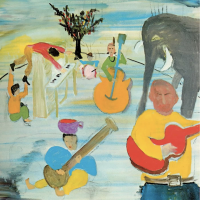"Music From Big Pink" Gets Double 45rpm Remix For 50th Anniversary Reissue
Books have probably been written about the album and certainly have been about the outfit known as The Band, the members of which though mostly unknown to buyers lured by a Bob Dylan cover (literally and musically), were touring and recording veterans—not that experience alone can explain what the group achieved here—with Levon Helm's contributions somehow increasing in significance over the years.
Only the rock cognoscenti knew "The Band" was formerly known as The Hawks and had backed Bob Dylan on his 1966 tour. And even then, the record, though well received by critics, didn't sell well.
Whatever was in "the ether" was well-captured by the engineers (not in that basement but at Phil Ramone's A&R Studios in New York [where Howard Stern's father once worked at a maintenance engineer] and at Capitol and Gold Star in Los Angeles) and by John Simon's atmospheric production that combined organics and subtly placed electronic fizz.
More than enough has already been written by many about the album. The editor's notes can be found in the review of Mobile Fidelity's fine all-analog reissue. Capitol previously released a forgettable vinyl edition a few years ago.
For the 50th anniversary, the label hired Bob Clearmountain to produce a remix from the original multitrack tapes, which probably numbered at most 8—at least that's what A&R at the time had.
Did the record need a remix? Arguably "no". It's not like Sgt. Pepper's... where 3 tracks were filled, mixed down to one (etc.—you know the story) and a much better and cleaner sounding mix was possible and was accomplished.
The good news here is that Bob Clearmountain didn't try to re-invent the album. Instead he treated the original mix with respect and made for the most part only modest "nips and tucks" that bring out subtle shifts in musical emphasis, none of which are going to be documented here, though I wonder why he felt the need to move the drums on "Tears of Rage" from the right channel to the left.
You can compare Mo-Fi to Capitol here:
One example of an improvement can be heard on "The Weight" (which is from where came the above samples—Clearmountain leaves in an engineer's verbal "slate"). The original has Levon Helm's vocals (and appropriately his drums) on the right channel. Clearmountain's mix places Helm and his drums in the center. It's well known that Clearmountain has embraced the digits and has little good to say about the analog holdouts, who he probably likens to a voodoo cult, so of course the mix was to high resolution digital.
If you have only an original Capitol 1968 pressing with its rolled off bass (below 80Hz) resulting from Capitol's rejection of Bob Ludwig's full, robust bass original cut (or so the story goes), either the Mo-Fi or this remaster is must-have (Ludwig mastered the files here so gets his "bass revenge").
This cut at 45rpm has robust bass, outstanding clarity, an obviously differently sourced reverberant backdrop and a somewhat less "organic" character than the Mobile Fidelity cut from analog tape. The staging is somewhat flatter, with images that are less round, but the clarity and precision of Clearmountain's deft mix and the 45rpm cut more than compensate (yes I wrote that) and provide a fresh perspective.
If I had to choose one, I'd still go with the Mo-Fi but if you're a fan of the record and you can afford a second edition (and you don't mind getting up twice as often), you will probably enjoy a subtly different, though equally enjoyable take on an album that truly deserves to be called a "classic". I'll be playing both.
The gatefold packaging is okay, though not as good as Mo-Fi's paper on cardboard "Tip on" style jacket. The GZ Media pressings (I think) were dead quiet, physically pleasing and flat.




